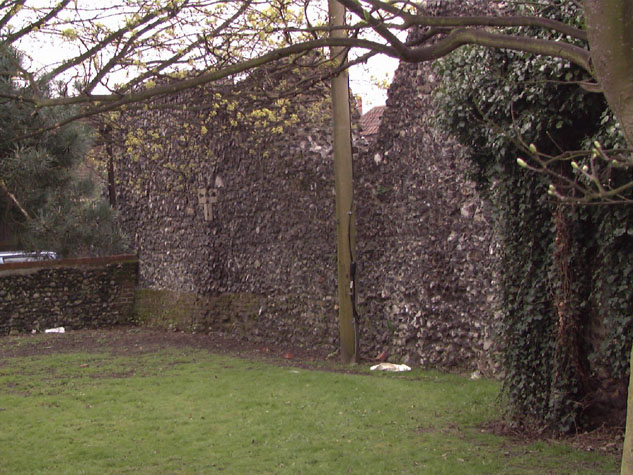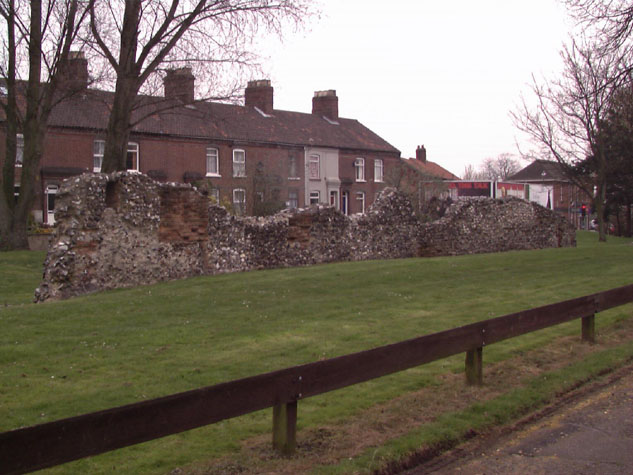|

[16]The outside of the wall at the east end from the north west.

[17]The inside of the wall at the west end from the south west.
|
Conservation Plan
The present setting:
The area is relatively quiet and is not a
part of the city visited by tourists. The wall is set well back from
St Augustine's Street which is relatively busy and is hidden by shops
and houses on the street frontage. Bakers Road is a residential
street with Edwardian terraced houses on the north side. Houses on
the south side of Bakers Road, backing onto the walls, have all been
demolished and the area is now a broad attractive grassed area with a good
planting of specimen trees. [16]
On the south side of the wall is a narrow
lane with a tight difficult entrance from St Augustine's Street so it is
little used except by local people. The area in front of the main
part of the wall is an unsurfaced parking area. Between the main
part of the wall and the lower section to the west is a brick-built
electricity sub station within a walled and fenced enclosure. The
building is of reasonable quality with a pitched roof and does not
seriously detract from the appreciation of the walls. Beyond the sub
station, the low section of wall has a broad grass verge on the lane side
with a low wood fence to stop cars parking here. [17]
Potential medium or long-term improvements recommended for the
surroundings:
This is one part of the city wall were the
outer ditch could be re-established at least for part of the length.
The technical problems of ensuring that the ditch drained and remained dry
would have to be resolved. Perhaps a water filled ditch might be
considered. Excavating the ditch should also reveal much more of the
north face of the wall particularly at the west end of the section.
Some trees on the north edge of the ditch could be retained.
Trees at the east end should be thinned and
the canopy raised to reveal more of the wall.
Lighting of the wall at the east end should
be considered.
A low retaining wall 800mm high and set in
front of the arches by about a metre should be constructed to reinstate
the medieval ground level of the top of the bank. This would return
the arches to their original proportions and would protect the base of the
wall and the face of the wall from damage as cars manoeuvre in the parking
area. The wall here faces south and the area could be turned into an
attractive area with seating and low level planting though some local
people and people working in nearby shops would resent the loss of a free
parking area.
Archaeological impact assessment:
If funds should be available for
archaeological work here there are several important areas where digs may
reveal much, particularly if the ditch is in part reinstated.
-
Excavations of the rectangular feature
to see what the internal plan was and see if there are the remains of
an earlier tower here. This could be undertaken without
disrupting the building of the sub station which is set forward of the
line of the wall.
-
Excavations along the inner line of the
wall to the west of the sub station should determine if the wall
arcade continued west beyond the tower.
-
The position of the west tower should be
sought initially through a non invasive geophysical or resistivity
survey.
CONSERVATION REPORT SUMMARY WITH RECOMMENDATIONS FOR ACTION
-
Immediate attention
-
Requires regular monitoring
-
Long term conservation
-
Improvements to the setting
Priority
-
Carefully prune back trees on the north side to raise the canopy and
reveal more of the wall
-
Clear vegetation from the top of the wall, particularly on the square
feature to the front of the sub station.
-
Construct a low retaining all 800mm high and about 1 metre in front of
the arches at the east end to protect them and to reinstate the medieval
level. If the wall had a wide capping this could be used as a seat
and the space behind should be filled level with gravel.
Long term
-
Consider reinstating the outer ditch.
-
Cut a trial trench across the line of the wall to see if the bank on the
inner side of the wall should be reformed to reflect the medieval profile.
-
If more of the wall to the west is uncovered this should be left on
display
-
If the ditch is not reinstated then the line of cobbles running west and
marking the line of the wall should be widened to give a truer impression
of the scale of the wall
BIBLIOGRAPHY:
Collins, Arthur E., The Walls of Norwich (City and County of
Norwich,
Norwich: Jarrold & Sons, 1910)
Hudson, William, and Tingey, John C., The Records of the City of
Norwich,
vol. II (Norwich & London: Jarrold & Sons, 1910), pp.
216-22, Extract from
The Old Free Book
DOCUMENTARY REFERENCES:
No medieval documents specifically for this section
|
